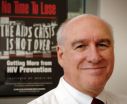(Press-News.org) WEST LAFAYETTE, Ind. – Researchers have shown how arrays of tiny "plasmonic nanoantennas" are able to precisely manipulate light in new ways that could make possible a range of optical innovations such as more powerful microscopes, telecommunications and computers.
The researchers at Purdue University used the nanoantennas to abruptly change a property of light called its phase. Light is transmitted as waves analogous to waves of water, which have high and low points. The phase defines these high and low points of light.
"By abruptly changing the phase we can dramatically modify how light propagates, and that opens up the possibility of many potential applications," said Vladimir Shalaev, scientific director of nanophotonics at Purdue's Birck Nanotechnology Center and a distinguished professor of electrical and computer engineering.
Findings are described in a paper to be published online Thursday (Dec. 22) in the journal Science.
The new work at Purdue extends findings by researchers led by Federico Capasso, the Robert L. Wallace Professor of Applied Physics and Vinton Hayes Senior Research Fellow in Electrical Engineering at the Harvard School of Engineering and Applied Sciences. In that work, described in an October Science paper, Harvard researchers modified Snell's law, a long-held formula used to describe how light reflects and refracts, or bends, while passing from one material into another.
"What they pointed out was revolutionary," Shalaev said.
Until now, Snell's law has implied that when light passes from one material to another there are no abrupt phase changes along the interface between the materials. Harvard researchers, however, conducted experiments showing that the phase of light and the propagation direction can be changed dramatically by using new types of structures called metamaterials, which in this case were based on an array of antennas.
The Purdue researchers took the work a step further, creating arrays of nanoantennas and changing the phase and propagation direction of light over a broad range of near-infrared light. The paper was written by doctoral students Xingjie Ni and Naresh K. Emani, principal research scientist Alexander V. Kildishev, assistant professor Alexandra Boltasseva, and Shalaev.
The wavelength size manipulated by the antennas in the Purdue experiment ranges from 1 to 1.9 microns.
"The near infrared, specifically a wavelength of 1.5 microns, is essential for telecommunications," Shalaev said. "Information is transmitted across optical fibers using this wavelength, which makes this innovation potentially practical for advances in telecommunications."
The Harvard researchers predicted how to modify Snell's law and demonstrated the principle at one wavelength.
"We have extended the Harvard team's applications to the near infrared, which is important, and we also showed that it's not a single frequency effect, it's a very broadband effect," Shalaev said. "Having a broadband effect potentially offers a range of technological applications."
The innovation could bring technologies for steering and shaping laser beams for military and communications applications, nanocircuits for computers that use light to process information, and new types of powerful lenses for microscopes.
Critical to the advance is the ability to alter light so that it exhibits "anomalous" behavior: notably, it bends in ways not possible using conventional materials by radically altering its refraction, a process that occurs as electromagnetic waves, including light, bend when passing from one material into another.
Scientists measure this bending of radiation by its "index of refraction." Refraction causes the bent-stick-in-water effect, which occurs when a stick placed in a glass of water appears bent when viewed from the outside. Each material has its own refraction index, which describes how much light will bend in that particular material. All natural materials, such as glass, air and water, have positive refractive indices.
However, the nanoantenna arrays can cause light to bend in a wide range of angles including negative angles of refraction.
"Importantly, such dramatic deviation from the conventional Snell's law governing reflection and refraction occurs when light passes through structures that are actually much thinner than the width of the light's wavelengths, which is not possible using natural materials," Shalaev said. "Also, not only the bending effect, refraction, but also the reflection of light can be dramatically modified by the antenna arrays on the interface, as the experiments showed."
The nanoantennas are V-shaped structures made of gold and formed on top of a silicon layer. They are an example of metamaterials, which typically include so-called plasmonic structures that conduct clouds of electrons called plasmons. The antennas themselves have a width of 40 nanometers, or billionths of a meter, and researchers have demonstrated they are able to transmit light through an ultrathin "plasmonic nanoantenna layer" about 50 times smaller than the wavelength of light it is transmitting.
"This ultrathin layer of plasmonic nanoantennas makes the phase of light change strongly and abruptly, causing light to change its propagation direction, as required by the momentum conservation for light passing through the interface between materials," Shalaev said.
###The work has been funded by the U.S. Air Force Office of Scientific Research and the National Science Foundation's Division of Materials Research.
Related website:
Vladimir Shalaev:
http://www.ece.purdue.edu/~shalaev
Birck Nanotechnology Center:
http://www.purdue.edu/discoverypark/nanotechnology/
IMAGE CAPTION
The image in the upper left shows a schematic for an array of gold "plasmonic nanoantennas" able to precisely manipulate light in new ways, a technology that could make possible a range of optical innovations such as more powerful microscopes, telecommunications and computers. At upper right is a scanning electron microscope image of the structures. The figure below shows the experimentally measured refraction angle versus incidence angle for light, demonstrating how the nanoantennas alter the refraction. (Purdue University Birck Nanotechnology Center image)
A publication-quality image is available at http://news.uns.purdue.edu/images/2011/shalaev-nanoantenna.jpg
Abstract on the research in this release can be found at: http://www.purdue.edu/newsroom/research/2011/111222ShalaevNanoantenna.html
'Nanoantennas' show promise in optical innovations
2011-12-23
ELSE PRESS RELEASES FROM THIS DATE:
New Dabota Chairs and Skidmore Chairs From Rattanland
2011-12-23
RattanLand, a Company specializing in the import and export of home furniture, has new products to offer to its customers worldwide - Dabota Chairs and Skidmore Chairs.
New Skidmore and Dabota Chairs
The Company is proud to announce two new products that have been added to its already impressive product range - Skid and Dabota chairs.
Skidmore chairs are classic looking chairs that come with a simple design. There are no armrests, and the chairs sit on four legs each. These chairs are ideal for the outdoor garden or porch.
Dabota chairs also come in a simple ...
Blood progenitor cells receive signals from niche cells and the daughter blood cells they create
2011-12-23
Maintaining balance is crucial. In Drosophila, the common fruit fly, the creation and maintenance of the blood supply requires such balance.
UCLA stem cell scientists have now uncovered that two-way signaling from two different sets of cells is necessary for that balance, both to ensure enough blood cells are made to respond to injury and infection and that the blood progenitor cell population remains available for future needs.
The stem cell-like blood progenitor cells – which contribute to the cells of the adult fruit fly's blood supply – receive signals from cells ...
Defending the genome
2011-12-23
WORCESTER, Mass. – Small, mobile sequences of DNA left over from viruses, called transposons or "jumping genes" because of their ability to move around the genome, pose a significant threat to the genetic integrity and stability of an organism. Considered genetic parasites, these transposable elements are believed to comprise as much as 50 percent of the human genome. Because of the damage transposons can do to an organism's DNA, an immune-like response has evolved to turn off, or silence, these mobile genetic elements.
New research published in the journal Cell by the ...
UNC HIV prevention research named scientific breakthrough of the year
2011-12-23
CHAPEL HILL, N.C. – The HIV Prevention Trials Network 052 study, led by Myron S. Cohen, MD of the University of North Carolina at Chapel Hill, has been named the 2011 Breakthrough of the Year by the journal Science.
HPTN 052 evaluated whether antiretroviral drugs can prevent sexual transmission of HIV among couples in which one partner has HIV and the other does not. The research found that early treatment with antiretroviral therapy reduced HIV transmission in couples by at least 96 percent.
The study was funded by the National Institute of Allergy and Infectious Diseases, ...
Built-in 'self-destruct timer' causes ultimate death of messenger RNA in cells
2011-12-23
December 22, 2011—(BRONX, NY) —Researchers at Albert Einstein College of Medicine of Yeshiva University have discovered the first known mechanism by which cells control the survival of messenger RNA (mRNA) —arguably biology's most important molecule. The findings pertain to mRNAs that help regulate cell division and could therefore have implications for reversing cancer's out-of-control cell division. The research is described in today's online edition of the journal Cell.
"The fate of the mRNA molecules we studied resembles a Greek tragedy," said the study's senior ...
Bacteria battle against toxic fluoride
2011-12-23
Regular use of fluoride-containing toothpaste and mouthwash has long been known to strengthen the enamel on teeth. But new research by Howard Hughes Medical Institute (HHMI) scientists finds that fluoride also has dramatic effects on bacteria inside the mouth -- including those that form plaque and can cause cavities.
HHMI researcher Ronald Breaker of Yale University has discovered the cellular chain of events that occurs inside a bacterium after it encounters fluoride in its environment. His team's findings reveal that many bacteria try to fend off fluoride – which the ...
Second Annual Holiday Fashion Show Benefit in New York City
2011-12-23
Long Island Exchange columnist Cognac Wellerlane interviews celebrities during a benefit for kidney transplant awareness.
On Tuesday December 6th an organization called the Flood Sisters hosted an annual Holiday Fashion Show Benefit to support their national kidney foundation. The organization, started by three sisters, is designed to support those willing to donate kidneys as well as those awaiting transplants. They believe that no one should have to suffer through painful treatments while waiting for an expendable organ.
The event was held at the Scandinavia House ...
Severe congenital disorder successfully treated in a mouse model for the first time
2011-12-23
Using a mouse model, Heidelberg University Hospital researchers have for the first time successfully treated a severe congenital disorder in which sugar metabolism is disturbed. The team headed by Prof. Christian Körner, group leader at the Center for Child and Adolescent Medicine, demonstrated that if female mice are given mannose with their drinking water prior to mating and during pregnancy, their offspring will develop normally even if they carry the genetic mutation for the congenital disorder. The team's outstanding work will contribute to better understanding of ...
Boxer Puts a Price on TV2
2011-12-23
At Boxer, we have decided to include TV2 in each of our four TV-packages, so our customers can keep viewing the channel. And on top of this, we are also making Danish TV-history by making it possible for our customers to purchase the channel (in Danish the term is Tv kanaler) separately. For the first time ever, our customers can choose to pay for a single channel without purchasing a full TV-package.
Here are the prices for TV2 purchased separately:
-19 kr./monthly subscription
-199 kr./annual card fee (primarily running and maintenance costs). The fee makes ...
When the mountains call . . .
2011-12-23
When the Mountains Call . . .
. . . don't climb too fast! Lack of acclimatization and excessively rapid ascent are the main risk factors for acute mountain sickness, as Kai Schommer and Peter Bärtsch explain in this issue of Deutsches Ärzteblatt International (Dtsch Arztebl Int 2011; 108 [49]: 839-48).
More and more tourists are climbing up mountains that are 5000 to almost 7000 meters high, such as Kilimanjaro, without any prior experience at high altitudes. The low oxygen content in the air can cause altitude sicknesses of various kinds.
For example, sudden vomiting ...


